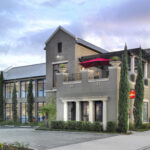CRE Matters
ECONOMIC AND INDUSTRY NEWS
Industrial activity for the second quarter is still hot, to put it mildly.
• Net absorption for the quarter registered 64.1 msf, up 4.9% from a year prior, which propelled year-to-date absorption to 126 msf. The South and the West led absorption gains, and the Midwest posted the greatest YoY improvement. Twenty-nine markets posted over 1 msf of absorption through midyear.
• No surprise then that the national vacancy rate remained at a record low 5% as vacancy rates declined from a year ago in 54 of the 79 tracked markets. Rents increased 7.2% from a year ago, with 18 markets reporting double-digit rent gains and 58 witnessing rent growth.
• New development continues to soar; the pipeline of industrial space reached more than 267 msf, by far the largest amount of space under construction in history. Starts jumped nationally by 8.1% quarter-over-quarter with 41 markets reporting increased development in the second quarter.
• Looking forward, the industrial market is on pace to eclipse the net occupancy gains of 2017. In fact, if we continue to absorb space at this rate, 2018 will be in the top five for total absorption over the past two decades.
The U.S. gross domestic product (GDP) grew at a 4.1% annual rate in the second quarter, the highest since Q3 2014.
• The GDP report also points to more strong growth in the rest of the year as inventories are replenished. Barring a major disruption, this could end up being the strongest year of the current expansion.
• This is critical for our business. Real estate is highly correlated with the performance of the economy. When consumers are spending, businesses are investing, and trade is flowing—real estate is needed. All this points to a great environment as we enter the second half of the year.
Consumers continue to be optimistic and are spending.
• The University of Michigan’s Consumer Sentiment Index dipped slightly to 97.9 in July, the lowest level since January. However, it marked the 21st consecutive month that the index was above 90 (generally considered optimistic).
• There were only two other times in the last 40 years when optimism lasted more than 21 months: the mid-1980s and the late 1990s during the dot com boom. Sustained high levels of optimism will lead to more spending and growth.
• Retail sales rebounded strongly in the second quarter as consumers spent their tax cut dollars. For the quarter, real retail sales were up at an annual rate of roughly 7.5%, compared with a basically flat first quarter.
Capital markets deal volume increased 2% in Q2 2018 from a year ago, but transaction volume and pricing activity are uneven across product types and tiers. Other highlights from Real Capital Analytics’ second quarter statistics include:
• Echoing the leasing data, Industrial continues to see the greatest increase in transaction volumes—up 17% in the second quarter YoY. Non-major metro warehouse volumes were up particularly strongly (+23% YoY), though prices (CPPI) are rising at a faster rate in the six major metros (+9.5%) YoY.
• Demand for apartments remains strong as single asset sales increased 5% in the second quarter YoY. Deal volumes in the six major metros (+13% YoY) and in the mid/highrise segment (+12% YoY) have seen a resurgence in activity. Apartment pricing meanwhile is rising faster than any other segment (+11.6% YoY).
• Office volumes (-17%) are declining for both CBD (-21%) and suburban (-13.5%) product, though suburban (7.9% YoY) and non-major metro (7.3% YoY) office continues to see robust price gains.
• Retail volumes jumped (+39% YoY) but this was entirely due to the closure of the Unibail-Westfield merger. Without this deal, volume was down 15% in the second quarter. Both prices and cap rates were essentially flat compared to a year ago, though the grocery segment continues to outperform.
Source: Cushman & Wakefield Research

